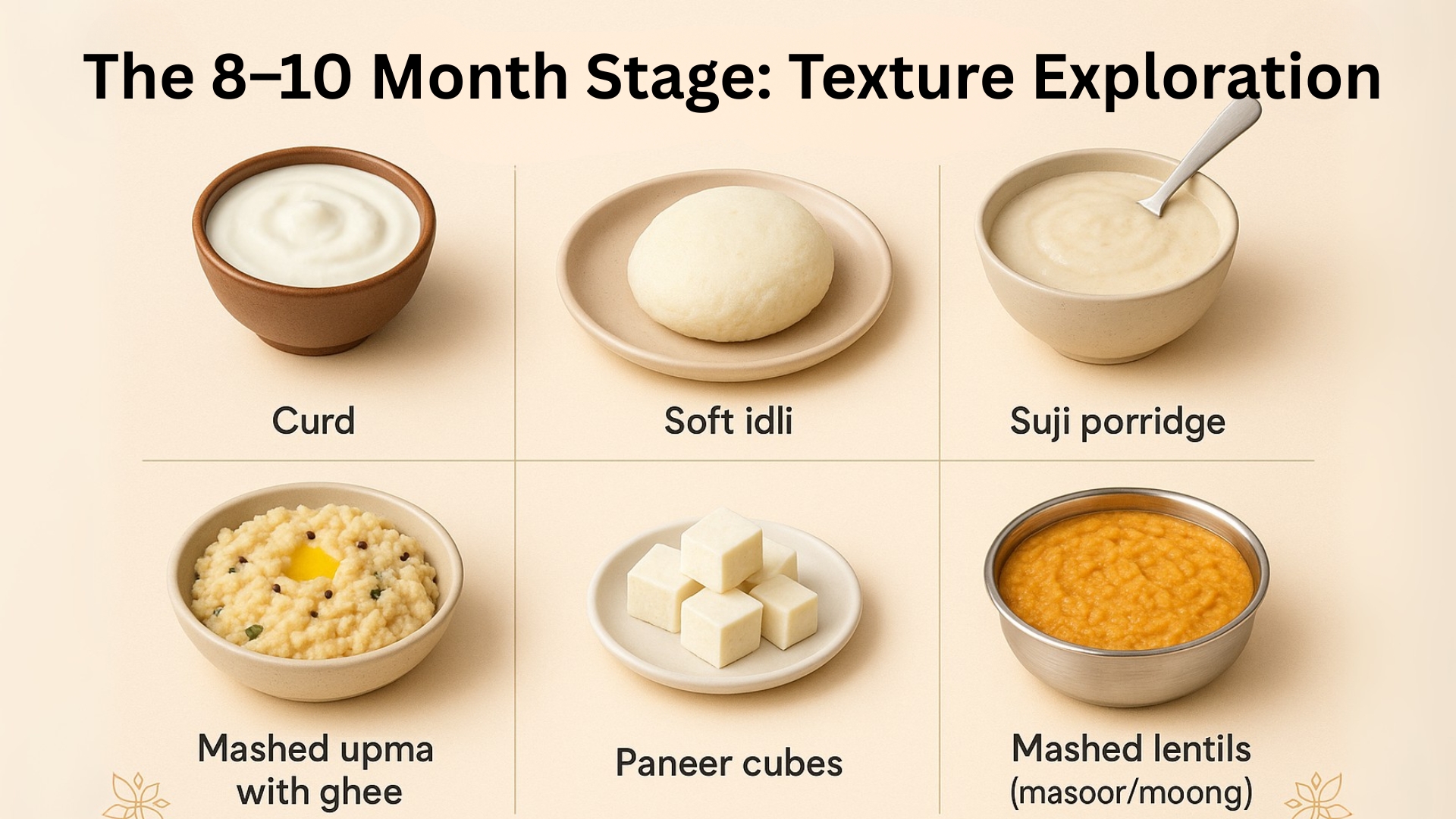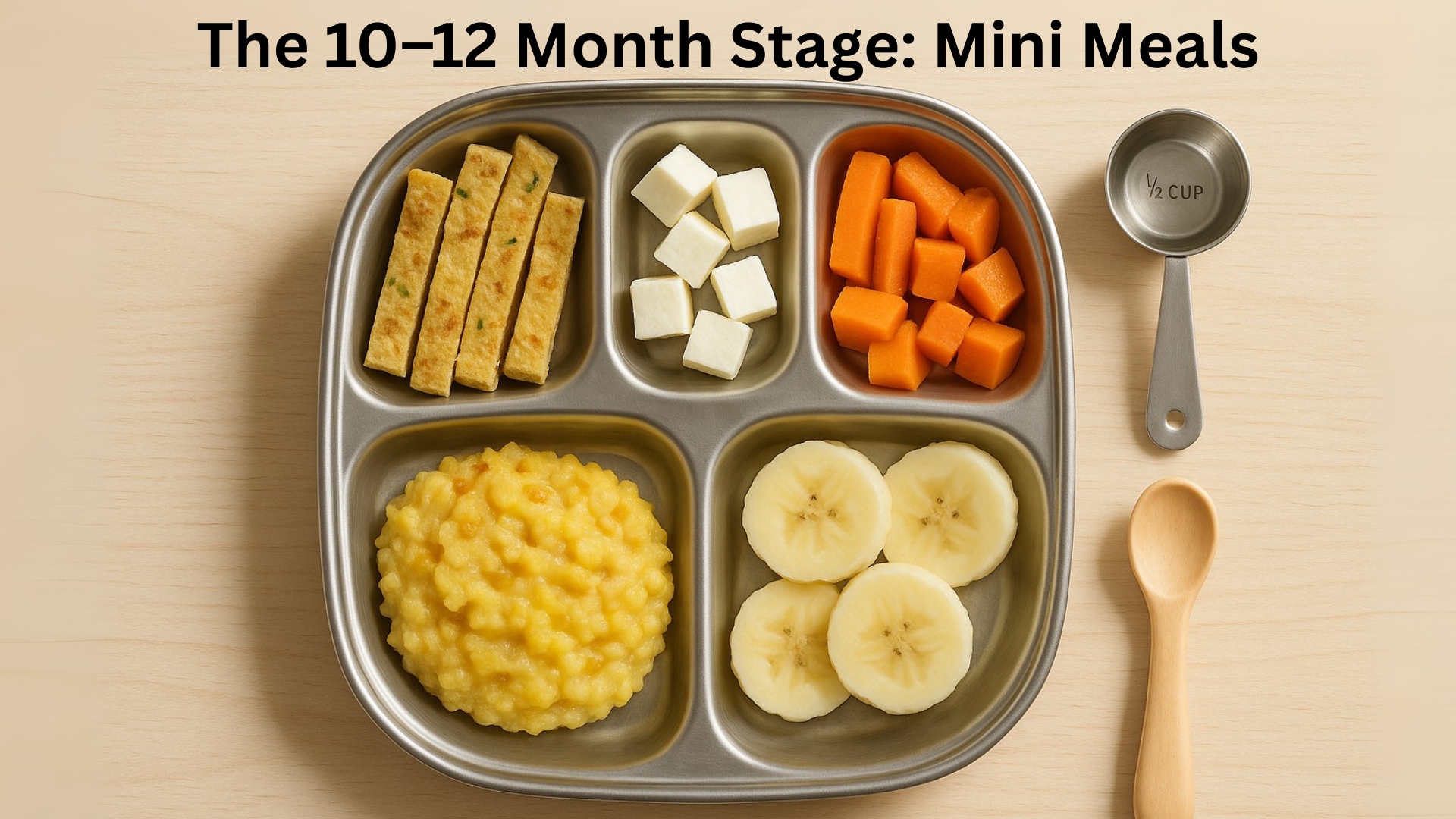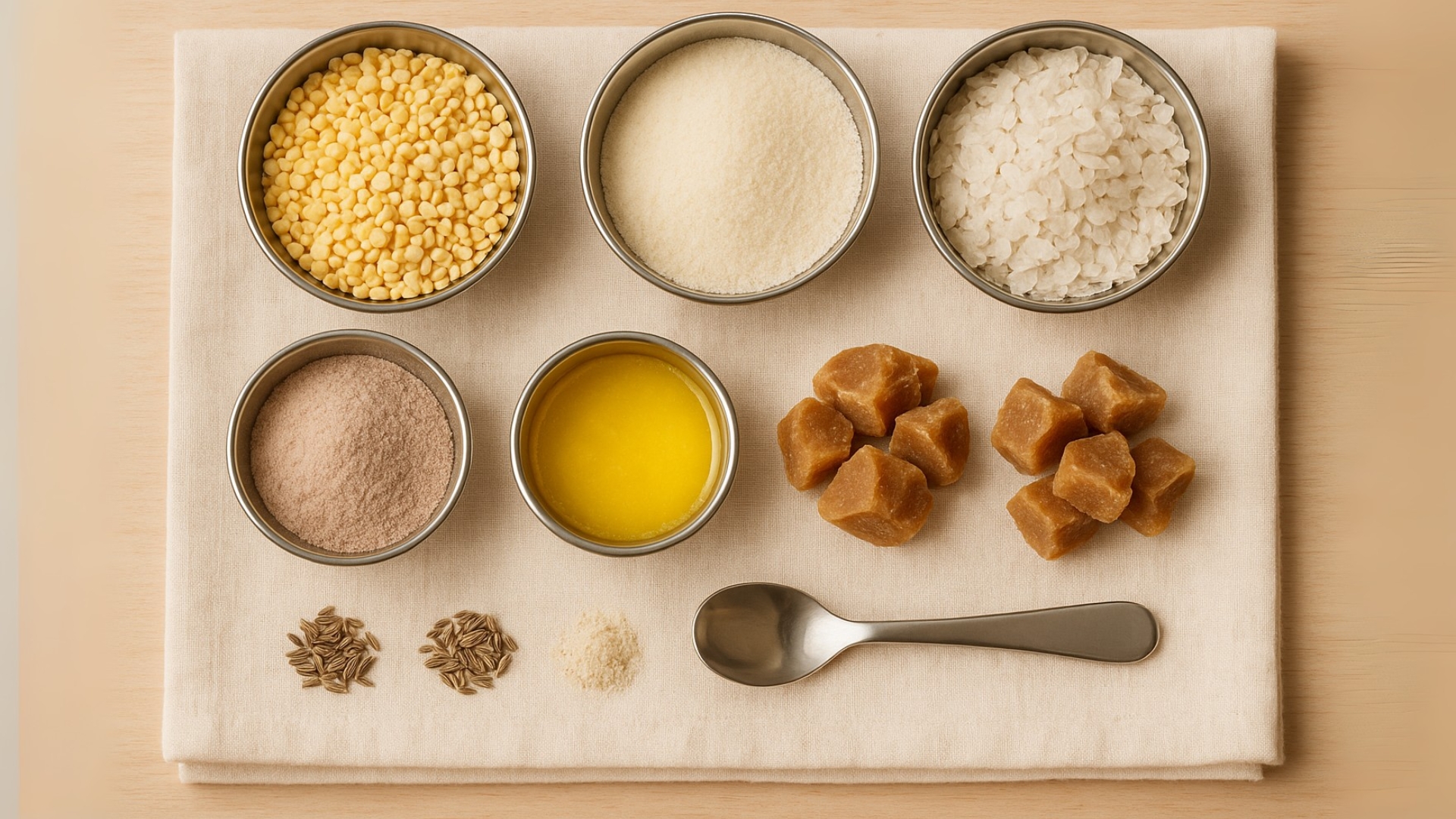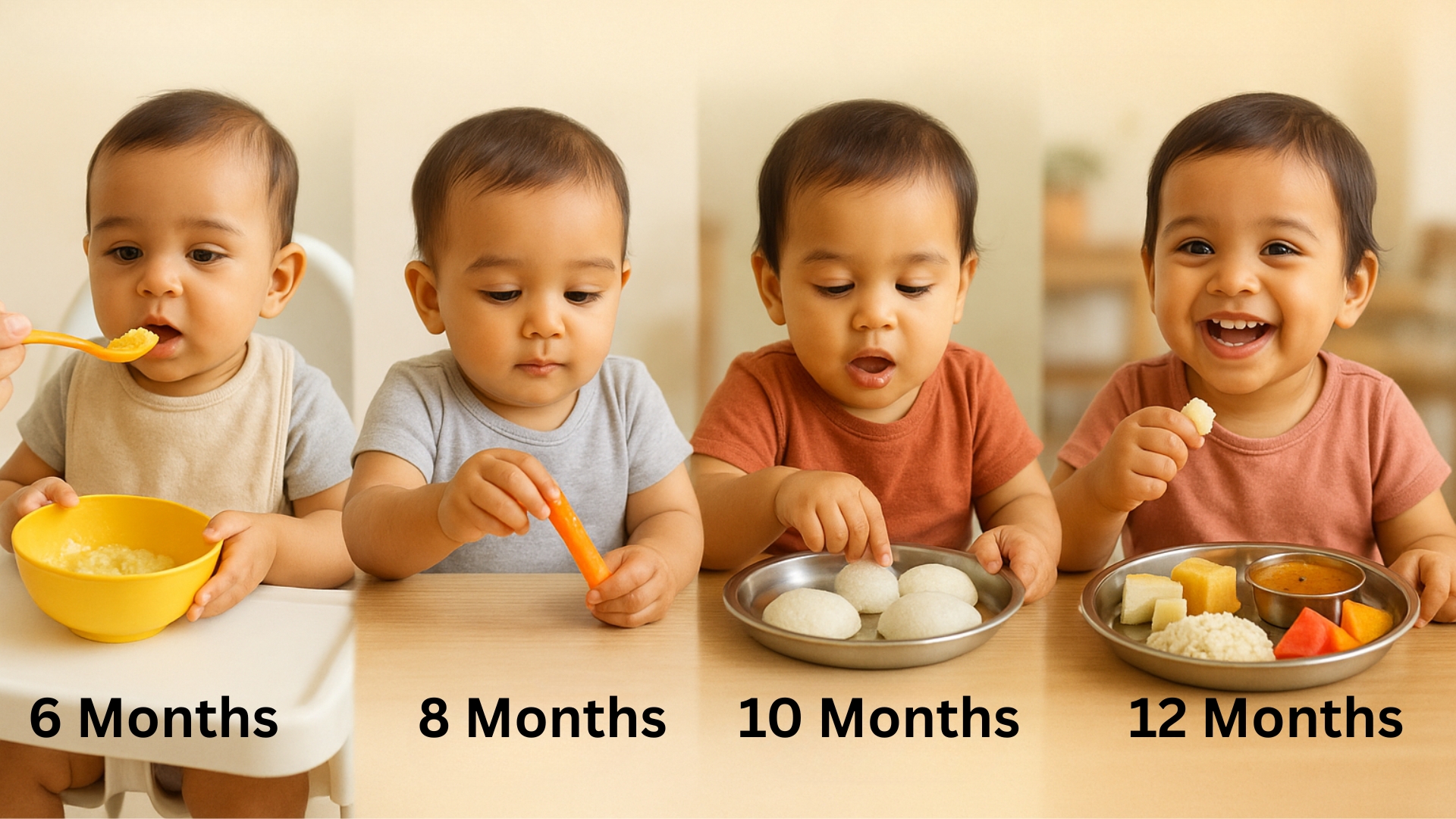Congratulations, parents! You’re about to embark on one of the most exciting milestones in your baby’s development — introducing solids to infants. This transition from a milk-only diet to incorporating wholesome foods is not just a change in meals, but a foundation for lifelong health and eating habits. As you explore this new chapter, understanding the basics of infant nutrition becomes essential.

The period between 6 to 12 months is a golden window — your baby’s taste buds are developing, digestive abilities are maturing, and the curiosity to explore textures and flavours is at its peak. This is when the nutritional needs for infants expand beyond breastmilk or formula, making it crucial to provide the right kind of nourishment.
During this phase, parents often face questions like:
- What is a balanced diet for an infant?
- How do I know what’s good food for infants?
- Are Indian recipes suitable for this age?
- What’s the ideal infant meal plan?
These are common concerns — and also surrounded by many myths! From being told to delay spices or certain grains, to hearing that bananas cause colds, parents often find themselves confused. That’s where we step in — to bust myths and guide you with scientifically-backed advice on the dietary needs for infants.
This blog is your trusted companion for understanding infants and nutrition, including portion sizes, safe foods, preparation tips, and age-appropriate Indian meals that are both nourishing and enjoyable. Whether you’re a first-time parent or navigating new challenges with your second baby, we’re here to support you.
Let’s walk together toward building a solid foundation for your baby’s growth with a healthy, joyful, and well-balanced diet for infants.
When to Start Solids: Is Your Baby Ready?
One of the most common (and confusing!) questions for parents is: “When should we start introducing solids to infants?” The answer lies not just in your baby’s age, but in a set of developmental signs that indicate readiness. Understanding these cues is crucial for supporting proper infant nutrition and ensuring a smooth transition from milk to meals.

Signs Your Baby is Ready for Solids
Experts agree that most infants are ready to begin solids at around 6 months of age. However, every infant develops at their own pace. Here are some clear signs to watch for:
Sitting upright with minimal support:
Your baby should have good head and neck control while sitting — a key requirement before feeding solids safely.
Loss of the tongue-thrust reflex:
This natural reflex pushes food out of the mouth. Once it fades, your baby can begin learning how to swallow.
Interest in food:
If your little one is reaching for your plate or opening their mouth when you eat, they’re showing curiosity about good food for infants.
Chewing motions:
Observing jaw movements is another sign they’re preparing to handle soft solids.
Recognizing these signals helps ensure your baby receives the right diet, aligned with their natural development.
Common Mistakes to Avoid
Starting too early (before 4 months):
Can increase the risk of choking and may not meet the evolving nutritional needs for infants.
Waiting too long (after 7 months):
Delayed introducing solids to infants can lead to feeding aversions and missed opportunities for iron-rich foods in the infant meal plan.
Ignoring texture progression:
Keeping the baby on only purees for too long may interfere with oral development.
Being mindful of these do’s and don’ts helps build a strong foundation for lifelong healthy eating and fulfils the dietary needs for infants in the most supportive way.
With the right timing, your baby’s journey into solids will be both exciting and nourishing — a true milestone in the world of infants and nutrition.
The 6–8 Month Stage: First Tastes
Welcome to your baby’s first real adventure in flavour! The period between 6 to 8 months is when most babies start introducing solids and exploring the joy of eating beyond milk. This is also a critical phase in supporting proper infant nutrition, as babies begin developing food preferences, digestive strength, and oral motor skills.

At this stage, the goal is not just to fill tummies but to meet the evolving nutritional needs for infants. Breastmilk or formula still remains the main source of nutrition, but now it’s time to supplement it with simple, soft, and nourishing solids.
Ideal First Foods for Indian Babies
When it comes to good food for infants, Indian kitchens are full of nutritious, gentle options that are easy to prepare and baby-friendly. Your baby’s first bites should be easy to digest, allergen-free, and mild in flavour. Here are some top picks:
Mashed fruits:
Banana, chikoo (sapota), and steamed apple are rich in vitamins and perfect for soft textures
Cooked rice water:
A light, hydrating introduction to grains
Dal water:
Packed with plant-based protein and iron
Mild Moong Dal Khichdi:
A soothing, wholesome dish that aligns well with the diet for an infant
These first foods gently begin to fulfill the dietary needs for infants, while building a habit of accepting spoon-fed meals.
Portion Size & Frequency
For 6–8 months, start small and go slow. Recommended portion size is about 1–2 tablespoons per meal, gradually increasing as your baby shows interest. Aim for 2 meals per day, in addition to regular milk feeds.
Remember: every baby is different. Some may love the spoon from Day 1, while others may need a few weeks. Be patient, and never force-feed — the journey is as important as the nutrition.
Feeding Tips: Texture, Timing & Frequency
Texture:
Begin with pureed or mashed foods. Make sure there are no lumps that may cause choking.
Timing:
Choose a time when your baby is alert, not too hungry or sleepy. Mid-morning or early afternoon works best.
Frequency:
Start with once a day, and slowly work up to two meals per day over a few weeks.
Following a consistent infant meal plan helps build mealtime routines and eases your baby into this new world of tastes and textures — a key component of infants and nutrition.
Sample Day Plan for 6–8 Month Old
Time | Meal |
7:00 AM | Breastmilk / Formula |
10:00 AM | Mashed banana (2 tbsp) |
1:00 PM | Breastmilk / Formula |
4:00 PM | Moong dal water or khichdi |
6:30 PM | Breastmilk / Formula |
As your baby grows, you can modify this infant meal plan based on hunger cues, preferences, and nap schedules.
By starting slow, offering gentle and age-appropriate foods, and following your baby’s cues, you’re not just feeding — you’re laying the groundwork for a lifetime of healthy eating and proper infant nutrition.
The 8–10 Month Stage: Texture Exploration
As your baby grows, so does their appetite — not just for food, but for variety! The 8–10 month period is an exciting time for introducing solids to infants in new ways. Your little one is now ready to move beyond smooth purees and embrace more complex textures, which supports oral development and lays the groundwork for self-feeding.

At this stage, infant nutrition is about more than just calories. It’s about helping babies explore, enjoy, and benefit from wholesome, balanced meals that meet their growing dietary needs. Introducing texture-rich foods, safe proteins, and diverse Indian ingredients makes this phase both fun and deeply nourishing.
Transitioning to New Textures
By now, your baby can handle more than just mashed food. You can gradually introduce:
- Soft chunks of steamed vegetables or fruits
- Mashed dals and khichdi with soft rice grains
- Thicker porridges and grain mixes
The goal is to give good food for infants with varying consistency — mashed, lumpy, and soft finger foods — while encouraging chewing motions. These textures help fulfil evolving nutritional needs for infants and promote independence in eating.
What to Add to the Diet Now
Indian kitchens are goldmines for baby-friendly dishes. Here are age-appropriate additions that support a well-rounded diet for an infant:
Curd (unsweetened) –
rich in calcium and probiotics
Soft idlis –
easy to digest and perfect for tiny hands
Suji (semolina) porridge –
soft, wholesome, and versatile
Mashed upma –
with ghee and finely chopped veggies
Paneer –
a gentle introduction to dairy proteins
Lentils (masoor, moong) –
excellent plant protein
These additions ensure the diet for infants is not only nutritious but also flavourful, varied, and enjoyable.
Portion Size & Frequency
By 8 to 10 months, most babies can eat 2–4 tablespoons per meal, having 3 solid meals a day, plus 1–2 healthy snacks. Continue breastfeeding or formula feeding alongside solids.
Following a structured infant meal plan helps ensure your baby gets all necessary nutrients, especially iron, calcium, healthy fats, and fiber.
Tips on Allergen Introduction
This is also the stage to begin gently introducing common allergens — one at a time, and in small amounts. Foods like curd, paneer, and wheat can be tried individually to monitor reactions. Always wait 3–5 days between new foods, and watch for signs of intolerance like rashes, bloating, or unusual fussiness.
Being strategic about allergens during this stage can actually reduce the risk of allergies later, while adding valuable variety to the dietary needs for infants.
The 8–10 month window is about giving your baby the opportunity to explore — both in flavour and texture — while meeting their growing infant nutrition requirements. It’s a time for variety, balance, and most importantly, joy. A well-planned infant meal plan with textured, protein-rich Indian foods sets the stage for healthy eating habits that last a lifetime.
The 10–12 Month Stage: Mini Meals
Your little one is officially graduating from mushy meals to mini meals! At this age, babies are more adventurous, developing better coordination, and eager to mimic adult eating habits. This stage is a crucial turning point in infant nutrition, where your baby starts to engage with food more actively — exploring textures, flavours and even self-feeding.

Between 10 to 12 months, the focus shifts from simply introducing solids to infants to helping them transition toward a more balanced, independent eating routine. It’s also the perfect time to move toward a sustainable infant meal plan that mirrors the family’s diet, with slight modifications.
Mini Meals & Finger Foods: Big Steps for Little Hands
Your baby’s pincer grasp is developing, and now is the ideal time to offer finger foods that they can hold, chew, and enjoy on their own. These mini meals provide the right mix of variety, nutrition, and fun — a great way to meet the evolving nutritional needs for infants.
Here are some great finger food options that align with the diet for infants:
Soft cooked vegetables
(like carrot sticks, sweet potato cubes, or bottle gourd)
Fruit slices
(banana, steamed apple, papaya)
Mini cheelas or dosas
(cut into strips for easy gripping)
Paneer cubes or Soft Tofu
Boiled lentils or soft rice balls
These are not only good food for infants, but they also encourage independence, sensory development, and mealtime confidence.
Sharing the Family Pot — with a Twist
At this stage, babies can start eating family foods — as long as they’re lightly spiced and low in salt. Homemade dal, vegetable sabzi, idli, poha, and chapati can be shared with your baby when served soft and portioned appropriately.
This inclusion ensures that the dietary needs for infants are met while gradually introducing them to your family’s cultural flavours. It also simplifies meal planning for parents and promotes a sense of togetherness at the table.
Portion Size & Frequency
By 10 to 12 months, babies generally consume about ½ cup per meal, with 3 meals per day and 2 snacks. Continue to offer breastmilk or formula, but the dependency will start to reduce as solid food becomes the primary source of energy and nutrients.
Following a flexible yet consistent infant meal plan at this stage helps to support healthy weight gain and prevents picky eating habits from forming.
Reducing Dependency on Milk
By the 12-month mark, typically less milk and more solids are needed to meet the nutritional needs for infants. Here’s how to reduce milk dependency gradually:
- Space milk feeds 2–3 hours apart from meals
- Offer solids first, then milk after 30–60 minutes if needed
- Include iron-rich foods like dals and leafy greens to replace nutrients from milk
Balancing solids and milk is the key to healthy infants.
Remember: by age one, solids should make up the majority of your baby’s calories, while milk becomes supplementary.
Foods to Avoid in the First Year
As exciting as it is to explore new foods with your baby, not everything that’s edible is baby-friendly. The first year of life is a sensitive period in infant nutrition, and knowing what not to offer is just as important as choosing good food for infants. This stage is all about laying a safe and strong foundation for lifelong health by being mindful of your baby’s still-developing digestive and immune systems.

While you’re busy introducing solids to infants, it’s essential to avoid certain foods that may pose risks — either because they’re hard to digest, allergenic, or potential choking hazards.
Foods to Completely Avoid Before Age One
Whether you’re planning your daily infant meal plan or experimenting with new textures, these items should stay off the menu during your baby’s first year:
Honey:
It can cause infant botulism — a serious illness. Even a small amount is unsafe.
Salt:
Your baby’s kidneys are still maturing. Avoid adding salt to any baby food; the dietary needs for infants are met naturally through whole foods.
Sugar:
Refined sugar can harm developing teeth and increase the risk of obesity later. Breastmilk and fruits provide natural sweetness, which is enough.
Cow’s milk (as a drink):
It lacks essential iron and may irritate the digestive system. Cow’s milk can be used in cooking but not as a primary drink before 12 months.
Whole nuts and large chunks:
These are choking hazards. Instead, offer nut butters (in tiny amounts, one at a time) after 6–8 months, under supervision.
Hard, round foods:
Grapes, popcorn, raw carrots, and chunks of apple should be avoided or modified to prevent choking.
Watching for Allergens: Go Slow & Smart
Food allergies are a growing concern in infant nutrition, but introducing allergens doesn’t have to be scary. In fact, research now suggests that introducing solids to infants, including potential allergens, sooner rather than later (after 6 months) may lower allergy risks.
Here’s how to do it safely:
- Introduce one allergenic food at a time — such as peanut butter, wheat, curd, or paneer.
- Wait 3–5 days before trying another new food.
- Watch for reactions: rashes, vomiting, diarrhoea, swelling, or excessive fussiness.
- Keep an antihistamine or doctor’s number handy in case of emergencies.
Smart allergen introduction supports comprehensive infant nutrition while building your baby’s immune resilience.
Myth-Busting: Let’s Set the Record Straight
In the world of infants and nutrition, there’s no shortage of myths passed down from well-meaning relatives. Let’s clear a few common ones:
❌ “Mangoes cause heat, so avoid them.”
✅ Not true. Mangoes are full of vitamins and make good food for infants. Just serve them ripe, soft, and in moderation.
❌ “You must add ghee generously to every meal.”
✅ Ghee is beneficial in small quantities, but excessive fat isn’t necessary in every meal. Stick to balanced fats that meet the nutritional needs for infants.
❌ “Sugar helps babies gain weight faster.”
✅ Untrue. A proper diet for an infant should focus on natural, nutrient-dense foods, not sugar-laden options.
By separating facts from fiction, you ensure your baby’s infant meal plan supports real health, not outdated traditions.
Safe & Smart – Healthy & Happy
Understanding what to avoid is a vital part of planning a safe diet for infants. By steering clear of unsafe items and focusing on nutrient-rich, age-appropriate foods, you’re making choices that align perfectly with your baby’s nutritional needs.
As you continue your journey in introducing solids to infants, trust the process, follow your baby’s cues, and stay informed. Each bite should not only nourish the body but also build confidence, taste preferences, and long-term wellness.
Must-Have Indian Ingredients for Your Baby Food Pantry
Creating nutritious meals for your baby doesn’t mean you need exotic ingredients or expensive baby food jars. In fact, Indian kitchens are already packed with wholesome, traditional ingredients that are perfect for fulfilling the nutritional needs for infants. These pantry staples not only support healthy development but also make introducing solids to infants simpler, tastier, and culturally rooted.

Here’s a list of must-have Indian staples that can elevate infant meal plan, support their growth, and meet the core dietary needs for infants with ease.
Wholesome Staples for Everyday Meals
Let’s start with some age-appropriate, nutrient-rich ingredients that are gentle on the stomach and versatile enough to be used across meals:
Ghee:
A small amount of homemade ghee adds healthy fats essential for brain development and energy. It also enhances taste and promotes digestion — a key part of effective infant nutrition.
Moong Dal:
A powerhouse of plant-based protein and iron, moong dal is easy to digest and ideal for khichdi, soups, and porridges.
Suji (Semolina):
Great for soft porridges and halwa, suji is a smooth grain that helps babies transition to thicker textures.
Poha (Flattened Rice):
Light, iron-rich, and easy to cook, poha can be softened into porridges or mashed with dal — a nutritious option in any diet for infants.
Millet Flours (Ragi, Bajra, Jowar):
Rich in calcium, iron, and fiber, millets are superfoods in the world of infant nutrition. Ragi porridge is especially popular for boosting strength and immunity.
Jaggery (after 1 year):
A natural sweetener rich in iron — perfect for replacing refined sugar in baby-friendly treats once your child turns one.
These ingredients check all the boxes when it comes to good food for infants — nourishing, affordable, and accessible.
Age-Appropriate Spices: Flavour without the Fire
Many parents worry about using spices too early, but when done mindfully, gentle seasoning can actually support digestion and introduce your baby to the flavours of your family table — an important step in introducing solids to infants.
Here are some safe, mild spices to keep in your pantry:
Jeera (Cumin):
Aids digestion and can be added to dals, khichdi, and soups in powdered form.
Hing (Asafoetida):
Just a pinch can help reduce gas and support gut health in the diet for an infant.
Ajwain (Carom Seeds):
Excellent for soothing colic or gas — can be dry roasted and powdered into food.
These spices not only support dietary needs for infants but also familiarize your baby with the wonderful palette of Indian flavours — a step toward lifelong healthy eating habits.
Healthy Fats & Iron-Rich Additions
For balanced infant nutrition, make sure your pantry also includes sources of:
Cold-pressed oils
(like mustard or coconut oil, used in tiny amounts)
Iron-rich foods
such as leafy greens (pureed), lentils, and ragi
Nut butters
(introduced after 8–9 months in small quantities, for protein and fat)
These additions play a crucial role in meeting the nutritional needs for infants — supporting brain development, immunity, and physical growth.
Simple Ingredients, Strong Foundations
By stocking up on these time-tested Indian ingredients, you’re making it easier to craft a sustainable, balanced, and delicious infant meal plan right from your kitchen. These staples simplify the process of introducing solids to infants, and help meet the daily dietary needs for infants without relying on packaged or processed foods.
In short, your kitchen is already equipped with everything you need to offer good food for infants — all it takes is a little planning and a pinch of love!
Sample Weekly Meal Plan for Babies (6–12 Months)
Planning meals for your baby doesn’t have to feel overwhelming. A well-balanced infant meal plan not only ensures your little one gets all the essential nutrients but also helps you introduce a variety of tastes, textures, and ingredients at the right pace. Whether you’re just introducing solids to infants or you’re in the later stages of the first year, a structured plan can be your best friend.
The following sample weekly baby food chart is specially designed for the 6–12 month age group.
Note: Continue breastfeeding or formula feeding alongside solids to meet the full nutritional needs for infants.
Day | Breakfast | Lunch | Dinner |
Mon | Suji porridge with banana | Moong dal khichdi | Steamed apple puree |
Tue | Mashed chikoo with rice cereal | Masoor dal with soft rice | Ragi porridge |
Wed | Soft idli with curd | Vegetable upma (mashed) | Mashed moong dal |
Thu | Apple-cinnamon oats | Dal rice with ghee | Mixed vegetable puree |
Fri | Mashed papaya with poha | Spinach-moong dal khichdi | Soft wheat porridge |
Sat | Ragi and banana mash | Carrot-peas khichdi | Dalia with veggies |
Sun | Suji halwa (lightly sweetened with fruit) | Family pot rice with mild curry (low salt) | Besan cheela strips |
Features of This Meal Plan:
- Designed to meet evolving dietary needs for infants
- Includes iron- and calcium-rich foods
- Introduces safe spices and diverse textures
- Uses familiar Indian ingredients suitable for all families
- Promotes flavour development and variety
Time-Saving Tips for Parents:
- Batch-cook dals and porridge bases to use across multiple meals
- Chop and store veggies in advance to save time on prep
- Use soft leftovers from your own meal (with modifications) to promote shared family eating — a great way to blend infant nutrition within the family routine
Planning ahead is one of the best strategies for successful infant nutrition, and this weekly chart helps simplify that journey while providing good food for infants every single day.
Whether you’re at the beginning of introducing solids to infants or already exploring self-feeding and textures, a flexible, nutrient-dense diet for an infant can help prevent nutritional gaps and build lifelong healthy eating habits.
FAQs
Q1. When should I start introducing solids to infants?
- Most babies are ready to begin introducing solids to infants around 6 months of age, once they show signs of readiness like sitting upright, good head control, and interest in food. Starting at the right time helps meet the growing nutritional needs for infants.
Q2. What is a good infant meal plan for a week?
- A balanced infant meal plan includes fruits, grains, protein, and vegetables in baby-friendly forms. Options like suji porridge, khichdi, mashed fruits, and soft idlis offer variety and nutrition.
Q3. What foods to avoid in the first year?
- Avoid honey, salt, sugar, cow’s milk (as a drink), whole nuts, and choking hazards. These may not align with the delicate infants and nutrition requirements during early development.
Q4. Can I continue breastfeeding while giving solids?
- Yes, absolutely. Breastfeeding continues to be a critical part of infants and nutrition even after 6 months. Solids are introduced to complement, not replace, breastmilk during this phase.
Q5. Is variety important in a baby’s first year?
- Yes! Offering diverse tastes, textures, and ingredients supports not just nutrient intake but also prevents picky eating later. A varied infant meal plan ensures a full spectrum of vitamins and minerals essential for growth.
Conclusion
Your baby’s first year is filled with joyful discoveries — and food plays a major role in that journey. As you’ve seen throughout this guide, infant nutrition isn’t just about feeding; it’s about nurturing curiosity, building lifelong habits, and ensuring every bite supports growth, immunity, and development.
We’ve explored the stages of introducing solids to infants, from the early days of purees and soft textures to more confident self-feeding and mini meals by 12 months. With the right approach and ingredients, crafting a nourishing and well-balanced infant meal plan becomes an achievable and enjoyable part of daily life. Using traditional Indian staples and age-appropriate techniques, you can create a diet that meets all the essential nutritional needs for infants without compromising on taste or convenience.

Throughout this blog, we discussed how to identify the right time to begin solids, how to build a structured diet for an infant, and which foods to embrace — and avoid. You’ve learned how to stock your pantry with good food for infants, introduce iron-rich and protein-packed ingredients, and create meal routines that align with your baby’s hunger cues and sleep patterns. We also helped debunk some common feeding myths and offered real-life tips for making the transition to solids smooth and stress-free — all while ensuring you meet the evolving dietary needs for infants in each stage.
Need help planning your baby’s meals? Our infant meal plan, designed by Dietician Deepti Gupta, offers customized support for every phase of your child’s growth. Whether you’re creating a weekly chart, introducing new ingredients, or just looking for clarity on the best diet for infants, expert help is just a click away. Book your consultation today and make confident, nourishing choices for your baby’s future.
For more information, go to our Homepage.